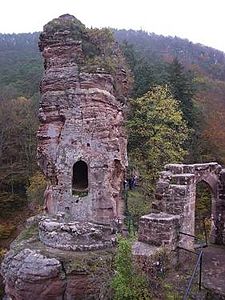
Château de Frœnsbourg
Encyclopedia

France
The French Republic , The French Republic , The French Republic , (commonly known as France , is a unitary semi-presidential republic in Western Europe with several overseas territories and islands located on other continents and in the Indian, Pacific, and Atlantic oceans. Metropolitan France...
castle
Castle
A castle is a type of fortified structure built in Europe and the Middle East during the Middle Ages by European nobility. Scholars debate the scope of the word castle, but usually consider it to be the private fortified residence of a lord or noble...
north west of the town of Lembach
Lembach
Lembach is a commune in the Bas-Rhin department in Alsace in north-eastern France.-Geography:Lembach lies in the Sauer valley, surrounded by the woods and sandstone cliffs of the North Vosges natural Park...
, within the Bas-Rhin
Bas-Rhin
Bas-Rhin is a department of France. The name means "Lower Rhine". It is the more populous and densely populated of the two departments of the Alsace region, with 1,079,013 inhabitants in 2006.- History :...
département. It has been listed since 1898 as a monument historique
Monument historique
A monument historique is a National Heritage Site of France. It also refers to a state procedure in France by which national heritage protection is extended to a building or a specific part of a building, a collection of buildings, or gardens, bridges, and other structures, because of their...
by the French Ministry of Culture. It is partially a troglodyte structure (built into the side of a cliff or mountain, using caves as connecting halls), with two main buildings making up the rest of the structure.
History
The castle was indirectly mentioned in 1235 (according to A. Thon). It is attested in 1269, in an account of the brothers "of Frundsperg". Until the 1340s, the castle would have belonged exclusively to the Froensbourgs, who had the same armorial bearings as the FleckensteinsChâteau du Fleckenstein
Château du Fleckenstein is a castle in the commune of Lembach, in the Bas-Rhin département of France. This fortress, built in the shape of 52 m long boat, has a long history. The castle was built on a sandstone summit in the Middle Ages...
(of which family they were probably a branch).
A little before the middle of the 14th century, the castle was divided between the lords of Froensbourg (who kept half of it), Loewenstein and Sickingen. It was besieged and ruined, in 1349, because of the banditry of Reinhard von Sickingen, but was certainly restored after 1358, the date when the castle was offered as a stronghold to the Palatine Count. The dwelling tower on the southern rock, known as the small castle, was owned towards the end of the 15th century by Fleckenstein, who had it restored. Its main door is dated 1481.
The big castle occupied the whole of the northern rock. At the higher level, on the side of a likely attack, is a keep
Keep
A keep is a type of fortified tower built within castles during the Middle Ages by European nobility. Scholars have debated the scope of the word keep, but usually consider it to refer to large towers in castles that were fortified residences, used as a refuge of last resort should the rest of the...
with living quarters towards the south. On the middle and lower floors were located the common buildings and dependences made of wood - traces of anchorings remain in the rocks - and troglodytic rooms. The lower courtyard stood in the west and there was a ditch to the north. There are several staircases cut into the rock. The castle was destroyed by the French in 1677 but was probably already abandoned at that time.
Architecture
The castle stands on an isolated sandstoneSandstone
Sandstone is a sedimentary rock composed mainly of sand-sized minerals or rock grains.Most sandstone is composed of quartz and/or feldspar because these are the most common minerals in the Earth's crust. Like sand, sandstone may be any colour, but the most common colours are tan, brown, yellow,...
spur oriented north-south, separated from the mountain by a large ditch. The spur, split in two, comprises a longer and higher northern rock, connected at mid-level by a modern footbridge to the southern rock. At the base of the northern rock, on the north-western side, a low room is cut into the rock and joined by a narrow bay (of unspecified date) to a tiny cylindrical room leading to the middle level. This could correspond to an old well-cistern. Above the door is evidence of the anchoring for a drawbridge
Drawbridge
A drawbridge is a type of movable bridge typically associated with the entrance of a castle surrounded by a moat. The term is often used to describe all different types of movable bridges, like bascule bridges and lift bridges.-Castle drawbridges:...
. Further south, a western projection with access door is located, a winding staircase cut in the sandstone, traces of buildings with a stable, a well in a corner and vestiges of staircases in the rock. At the middle level, to the east (reached via a modern staircase and a largely original door) are two rooms cut in the rock; to the north is the upper part of the old well-cistern. Towards the south, a square cistern close to the modern footbridge gives access to the small southern rock. This is entirely occupied by the remains of the dwelling tower whose Gothic
Gothic architecture
Gothic architecture is a style of architecture that flourished during the high and late medieval period. It evolved from Romanesque architecture and was succeeded by Renaissance architecture....
arch doorway remains, dated 1481.
The remains of the northern keep and the lodgings towards the south, located on the higher terrace of the northern rock, are inaccessible.

